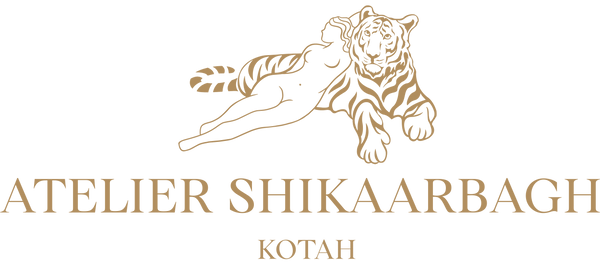The Origins of the Brand

Atelier Shikaarbagh grew out of a lady’s fondness to drape herself in the best luxurious French chiffons and to continue the tradition of patronage which was a legacy which had passed down from centuries . With the help of his grandmother, the late Rani Urmila Rajey of Dholpur , as well as the late Rajmata Gayatri Devi of Jaipur , our founder and Head Designer Maayankraj was able to hone his expertise in sarees and various costumes. His grandmother had employed a retinue of skilled embroiderers from Dholpur, who now form the core of his team.
This relationship which combined the best of Indian craftsmanship and finest French fabrics persevered amidst the tumultuous socio-political times 0f the 1930 till the 1970’s by Rani Urmila Rajey , which has been later carried on in the form of Atelier Shikaarbagh by Maayankraj Singh , and has quietly and steadily consolidated its reputation as a trusted, beloved purveyor of the finest quality French and Indian chiffon, silk tissue and georgette sarees, with bespoke wedding poshaks, Wedding Gowns and Formal Eveningwear.
The essence of each garment is steeped in heritage craft and design narratives that have stood the test of time. The expression molds itself to the vision and desires of a proud traditional patron, finding their personal signature in a rapidly evolving local, regional and international fashion and styling arena.
This seamless amalgamation of essence and expression is evident in the showcase of traditional needlework techniques, like aari, zardozi, fareesha, nakshi, taarajadai (sequin work), motijod (beadwork), marodi as well as the best of French techniques, such as French knotting, French sequin work, Chantilly lace work, pearl work, silk floss, and crewel work. Authentic foundation fabrics and raw materials are sourced from the best suppliers in India, Middle East and France.
The color palette of Atelier Shikaarbagh is an interesting mix of vibrant jewel tones, inspired by the Toshakhanas of regal India - spinel pinks, ruby reds, and emerald greens, besides peacock blues, and saffron yellows and oranges, alongwith quintessential English and French palette, with rose, madder, cerulean, azure, mint, apricot, grape, blush, and sky; besides classic beige tones, white, and black, inspired by the Edwardian era. The flagbearer color remains a classic moonlit pink. The dyeing is exclusively done by 10th generation, in-house dyers. The mutually sacred, respectful relationship - between the families of these experts, and that of Maayankraj’s - goes back about 300+ years.
Atelier Shikaarbagh fulfills a gap in the market for fine garments that harmonize the making of a dramatic statement, and that of understated sophistication.
Atelier Shikaarbagh’s loyal, and fast-growing clientele includes Mrs. Kokilaben Ambani, Mrs. Nita Ambani, Mrs. Smriti Z Irani, Princess Sarvath al-Hassan, Mrs. Sharmila Tagore, Mrs. Hema Malini, Mrs. Kareena Kapoor Khan, Ms. Jahnavi Kapoor and members of Indian and International royal families.
About the Designer
Growing up surrounded by a collection of heirloom English master paintings, one of the only collections of Edwardian costumes in India and a great wealth of experience trickling down the annals of history, Maayankraj’s educational credentials also reflect the love and appreciation of art and culture as he holds a Master in the History of Arts from Maharaja Sayajirao University, Vadodara. In the year 2010, he recorded the ‘Oral History of Rajput Royal costumes ‘as a written thesis, through extensive travel and research pan India. These endeavors have profoundly sensitized him to the patronage, workmanship and various nuances of Haute Couture.
Maayankraj is a self-taught milliner, an antique garment restorer, a polyglot who is fluent in many regional and European languages. He is working diligently to preserve the only collection of antique garments in India.
Atelier Shikaarbagh is currently headquartered in Kotah (Rajasthan). Maayankraj, who hails from the erstwhile aristocratic family of Kayasthpada, Dholpur, has called Kotah his second home since his family moved there in 1965.
